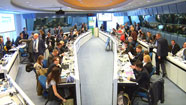On 5 April 2016 the JRC presented the interactive and collaborative online European Energy Efficiency Platform. This beta platform is conceived to fill the gap opened by scattered data and fragmented knowledge resulting from a rapidly growing energy efficiency market. It is expected to be both a one-stop shop for information retrieval and a meeting point for experts to exchange data and reduce redundant activities.
Snapshot of renewable energy development in the EU-28, Volume 2

- EU as a whole and the majority of Member States are on track to achieve the 2020 energy targets.
- The binding Renewable Energy Directive targets are playing an important role in the transformation of energy mix portfolio in European Union
Policy Context
EU Member States (MS) have committed to implementing the EU’s 2020 Climate and Energy Package, adopted in 2007 and enacted in 2009 with Renewable Energy Directive (RED).
Under Article 4 of RED, each MS submitted in the course of 2010 their national renewable energy action plans (NREAPs) showing how they were going to reach the renewable energy targets in the electricity, heating/cooling and transport sectors.
Under Article 22 of the RED, each Member State submitted to the European Commission the first and second set of bi-annual progress report on the developments in renewable energy sources covering 2009-12 period.
Key conclusions
A high level of renewable energy penetration presents unique challenges for the EU energy system, but also provides a viable option for the future path towards 2050 climate and energy targets.
The fast penetration of technologies as wind, photovoltaics and heat pumps are consolidating the position of renewables as an indispensable part of the European energy mix portfolio.
Main findings
Between 2005 and 2012 relevant changes took place at EU as a whole and each Member State energy markets (electricity, heating/cooling and transport) in which renewables are competing with fossil fuels and other non-renewables.
Renewable energy share in European Union increased from 8.2% in 2005 to 14.15% in 2012 and furthermore to 14.95% in 2013.

In absolute terms final consumption of renewable energy has continued to progress and it is expected to grow annually by 7% between 2012 and 2020, reaching 248.2 Mtoe.
In 2012 renewable heat experienced the fast expansion of heat pumps (growing by a steady 41.4% per year from the baseline) and biomass sources now contributing with 53.7% share in renewable energy mix. Renewable heat production exceeded the expectations laid down in the aggregated NREAPs in both 2011 and 2012.
Renewable electricity 2012 contribution in final consumption of renewables arrived to 40.2%, almost reaching the NREAPs planned figure for 2012 and profited by a very fast increase in photovoltaics that showed in 2012 a CAGR of 72.4% from the baseline year while wind power almost tripled its absolute contribution in the final renewable electricity consumption compared with the figure in the baseline year, although remaining behind the expectances.
Renewable energy in transport lagged behind the plans in both 2011 and 2012 Many MS didn't report about the use of biofuels in transport sector limiting the contribution of renewables in this sector at only 8.4% of final consumption of renewables.
In 2012 biomass dominated the overall renewable energy mix followed by hydropower (17.9%) wind (10.8%), biofuels (7.5%), solar (5.1%), heat pumps (4.3%) and geothermal (0.7%).

23 MS met or surpassed the expected overall RES share in year 2012 while in 2011 this figure was 18. In 2012 the penetration of renewable heat/cold in 19 MS was more than half of their final renewable energy consumption.
This figure was lower for renewable electricity which represented more than half of their final renewable consumption in 4 MS (IE, ES, HR and UK).
Relative importance of the penetration of renewables used transport sector at each MS final renewable energy consumption was higher than the average EU-28 figure (8.4%) for 13 MS.
Sweden and Bulgaria exceeded in 2012 the overall RES share target for 2020. Bulgaria, Estonia, Malta, Austria, Romania, Finland and Sweden exceeded in 2012 the expected respective 2020 renewable energy shares in heating/cooling sector.
Italy was the only MS that exceeded in 2012 the 2020 renewable electricity share mostly due to have doubled the 2020 planned installation in photovoltaics.
Sweden was the only MS that in 2012 exceeded the 2020 plan of renewable energy share in transport sector due to the fast increase in the use of biodiesel.
Related and future JRC work
This report complements the set of reports on renewable energy deployment published by JRC-IET, based on national renewable energy action plans and bi-annual progress reports to assess the progress towards 2020 Climate and Energy targets.




To quote this article use the follonwing format: